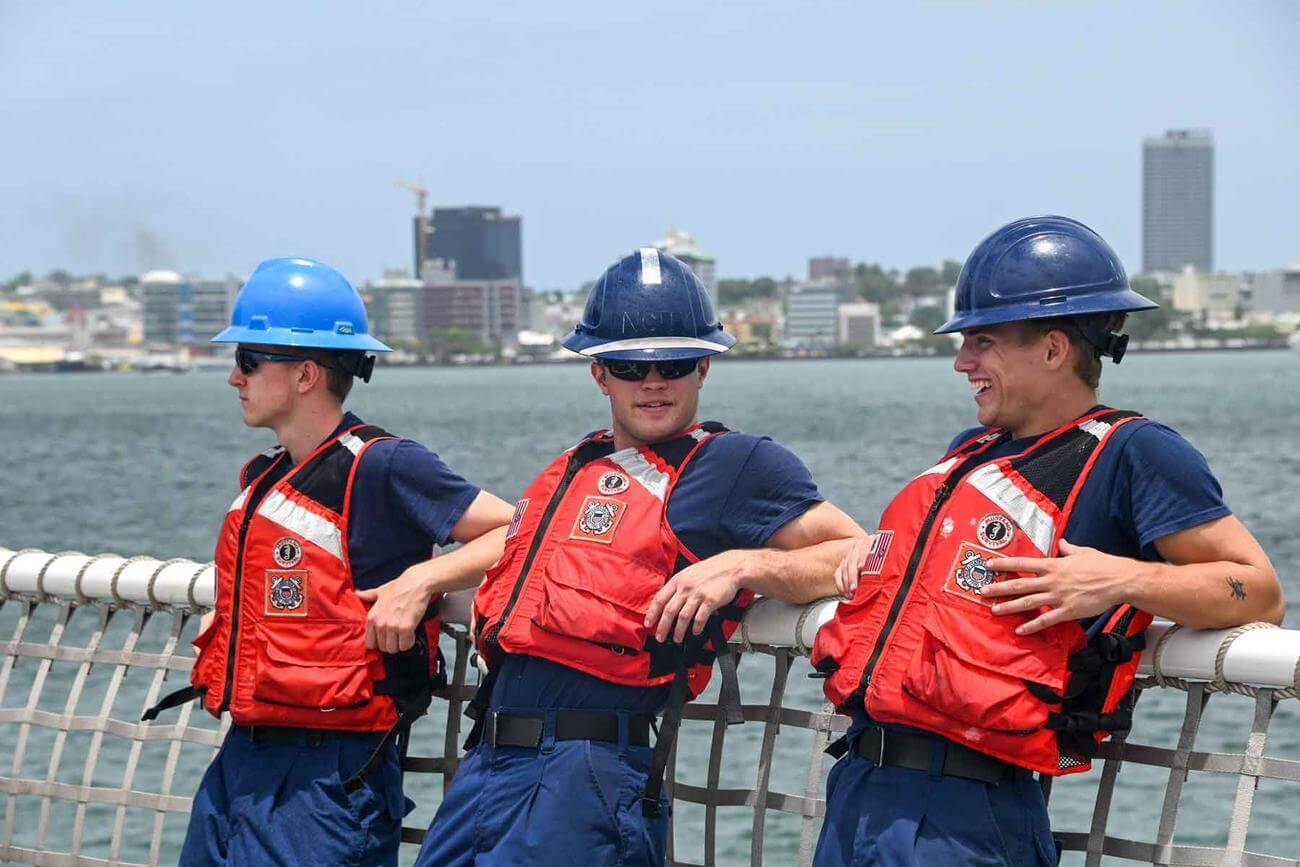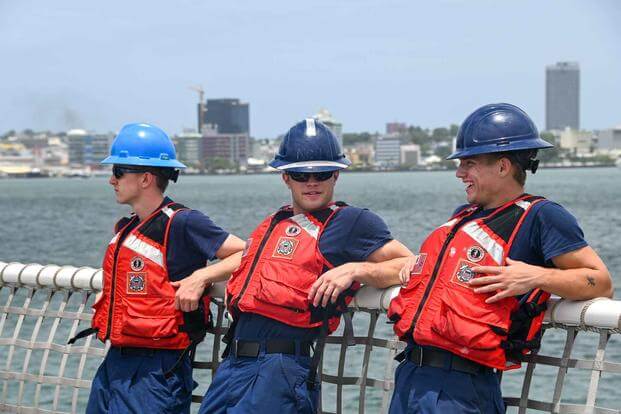

The Coast Guard is slated to continue solidifying its Pacific footprint with new funds from Congress as the service plays an increasingly prominent role in Washington’s regional strategy.
The U.S. House Committee on Appropriations in June approved measures funding federal homeland security and foreign affairs programs for the upcoming fiscal year 2025. That includes $2.1 billion for the U.S. government’s Indo-Pacific Strategy and $175 million for assistance specifically for Pacific island countries.
The Coast Guard was the only military service mentioned by name in the White House’s Indo-Pacific strategy, which is largely aimed at challenging China as Beijing and Washington compete for influence.
The Coast Guard is the only U.S. military branch to be part of the Department of Homeland Security rather than the Department of Defense—though it is integrated into the Navy’s chain of command in times of war. Officials view the service—with its mixture of military, law enforcement, environmental and public safety missions—as an ideal emissary to win and maintain friends in the Pacific.
The current draft legislation includes $60 million to allow the Coast Guard to base another Medium Endurance Cutter in District 14—the area of operations that includes the Pacific islands and is headquartered in Honolulu—as well as other funds set aside for the Coast Guard’s expanded presence in the Pacific islands region.
The Coast Guard in 2023 reassigned the Medium Endurance Cutter CGC Harriet Lane from Virginia to Honolulu to serve as the service’s first “Indo-Pacific Support Cutter ” devoted to Oceania, with a major emphasis on helping Pacific island nations protect their waters from illegal fishing.
The Medium Endurance Cutters—known as “270s ” to Coast Guardsmen for their 270-foot length—are new to the region. U.S. Rep. Ed Case, D- Hawaii, pushed for the Lane’s reassignment to Honolulu for Pacific operations and has advocated for increased Coast Guard funding across the board.
The current draft of the spending legislation also includes $3 million to increase the presence of regional Coast Guard advisers as well as $1.2 million for the Coast Guard’s Indo-Pacific Workforce Support Project, which includes funds to increase housing, medical and child care access and capacity in Hawaii and Guam to support the service’s Pacific operations. It also calls for the service to acquire a new pier at its Sand Island base, expand facilities and come up with a report on infrastructure at Coast Guard Air Station Barbers Point.
However, while the legislation included many provisions Case fought for, he ultimately voted against it.
House Republicans also included provisions that slashed several diplomatic and aid programs—including prohibitions against funding to several United Nations agencies—and put heavy restrictions on immigration that Case said “supports a one-sided approach to immigration policy and does not secure the border by failing to invest in sustainable and critical immigration reform that would both strengthen border security and benefit American families and businesses.”
“Unfortunately, even with these proposed resources for Hawaii and the Indo-Pacific, I could not support the overall measure in its current form because of the areas in which it underfunds critical operations, ” Case said. “As we continue to focus on the growing influence of China in the Indo-Pacific, our national security interests must also include diplomatic engagement and assistance to promote peace and diplomacy in the region. … I am committed to fixing these problems as we work through the legislative process toward final versions of these bills that can correct these deficiencies, secure bipartisan support and be signed into law.”
However, the Coast Guard has continued to receive broadly bipartisan support. Its Pacific shift began ramping up under the presidency of Donald Trump, and since 2020 it has boosted its presence with several new fast-response cutters home-ported both in Hawaii and Guam. Those relatively small and nimble vessels can enter smaller island harbors that larger vessels can’t fit inside, but their small size also limits how far and how long they can operate at sea.
The Coast Guard is turning to the Medium Endurance Cutters, or 270s, for more sustained operations. The Harriet Lane did its first patrol in its new role from January to April on a 79-day deployment that took the cutter and its crew to port calls in American Samoa, Samoa, Fiji, Vanuatu, Australia, Papua New Guinea, Nauru and the Marshall Islands. Over the course of the patrol, the Lane’s crew participated in 27 vessel boardings and documented a dozen violations of fishery laws in partnership with authorities from across the region.
In February 2023, Rear Adm. Michael Ryan, Coast Guard deputy commandant for operations and policy, told military news outlet Defense One that the service intends to triple its deployments in the Pacific in coming years. But by December, shortfalls in retaining and recruiting Coast Guardsmen in part forced the service to shut down several facilities and vessels.
Now, as demand for the Coast Guard in the Pacific continues unabated, the service has been feeling the strain as it fights for funding and resources. At 43, 000 active-duty members, it used to be the smallest branch before the creation of the newly formed Space Force, which counts just over 4, 000. But the Space Force’s proposed budget next fiscal year of roughly $29.4 billion dwarfs the roughly $14.2 billion the Coast Guard is slated to receive.
During an embedding by the Honolulu Star-Advertiser aboard the Harriet Lane during its first Pacific deployment, the ship’s crew was open about the struggles of working in a force that’s undermanned. A fully staffed Medium Endurance Cutter has a crew of about 100, but low recruitment and retention mean Lane has relied on a revolving door of crew members and personnel on temporary-duty assignments to keep it running.
The 270s are also old ships. The Harriet Lane is 40 years old and arrived in Hawaii in December after undergoing over a year’s worth of renovations at a Baltimore shipyard. Even after the overhaul, several crew members said that maintenance and getting spare parts to keep the Harriet Lane running all the way in the Pacific have posed significant challenges.
The Harriet Lane’s captain, Cmdr. Nicole Tesoniero, said that ultimately the vessel serves as a “stopgap ” until the service can bring a newer, better medium-size cutter to the Pacific, telling the Star-Advertiser, “It’s great that a 40-year-old ship can do it, (but ) I think that’s 100 % on the backs of the crew, because of their desire to keep the ship in the condition that it is.”
That newer, better ship is supposed to be the Heritage Class Offshore Patrol Cutter. But so far, of the 11 planned, none have entered service. Originally set to enter service in 2021, the program has lagged along with other shipbuilding projects across the United States as aging American shipyards struggle to keep up with both maintenance and construction demands. The first of the Heritage-class cutters expected to enter service is the CGC Argus, with a projected commissioning in September. It is expected to be stationed in San Pedro, Calif.
The Harriet Lane is already on its next patrol. The vessel is currently home-ported alongside Navy ships at Pearl Harbor rather than with other Coast Guard cutters at Sand Island due to lack of pier space and support resources. As it left it made space for international warships that are in Pearl Harbor for Exercise Rim of the Pacific, the world’s largest recurring naval warfare exercise.
___
(c)2024 The Honolulu Star-Advertiser
Visit The Honolulu Star-Advertiser at www.staradvertiser.com
Distributed by Tribune Content Agency, LLC.
© Copyright 2024 The Honolulu Star-Advertiser. All rights reserved. This material may not be published, broadcast, rewritten or redistributed.
